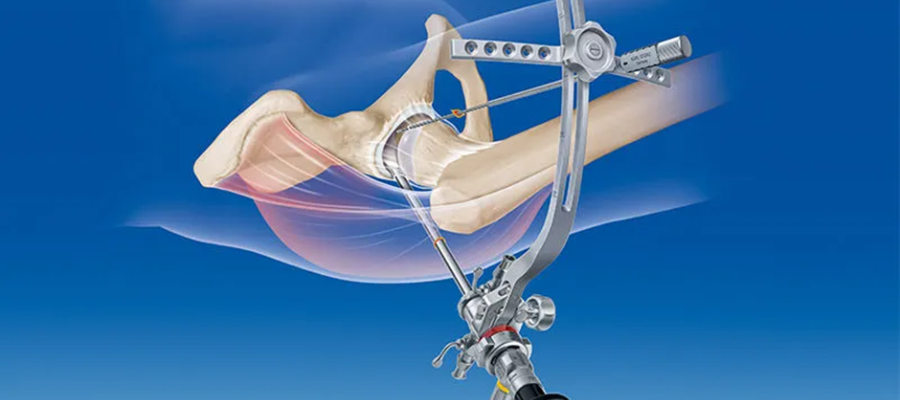Common Hip Problems Treated with Arthroscopy
Hip arthroscopy is a minimally invasive procedure that helps in both diagnosing and treating various hip conditions. It is commonly used to repair labral tears with sutures, remove loose fragments of bone or cartilage, and shave down excess bone in cases of hip impingement. The procedure can also address cartilage damage to help slow the progression of arthritis, clean the joint in cases of infection, and relieve stiffness by releasing tight tissues. This approach allows for quicker recovery, less pain, and improved hip function compared to traditional open surgery.
Procedure of Hip Arthroscopy in Simple Language
Here’s how the procedure works:
Hip arthroscopy is usually performed as a day-care procedure and takes about 1–2 hours. The process begins with administering anesthesia to ensure a completely pain-free experience. The surgeon then makes small incisions around the hip joint, through which a miniature camera (arthroscope) is inserted to project live images on a monitor. Using fine surgical instruments, the surgeon repairs or removes the damaged tissues as required. Once the treatment is completed, the small incisions are carefully closed with sutures or surgical tape. After the procedure, patients are monitored in the recovery room for a short period and are often able to return home the same day.
Hip Arthroscopy vs Open Surgery
Arthroscopy offers significant advantages over traditional open hip surgery.
Benefits of Arthroscopic Hip Surgery
- Minimally invasive with quicker healing
- Smaller scars and less visible marks
- Reduced hospital stay, often same-day discharge
- Faster recovery time and improved mobility
- Lower risk of complications
- Long-term pain relief and better hip function
Who requires Hip Arthroscopy?
You may be an ideal candidate for hip arthroscopy if you have been experiencing hip pain for more than three to six months that has not improved with medication or physiotherapy. This procedure is particularly beneficial for active individuals, such as athletes or young adults, who wish to restore full hip mobility. Diagnostic imaging, such as MRI or X-rays, showing labral tears or signs of hip impingement can indicate the need for arthroscopic intervention. However, patients with advanced arthritis may not be suitable candidates, as severe joint degeneration often requires hip replacement rather than arthroscopy.
Post-Surgery Care & Recovery
After hip arthroscopy, proper post-operative care is crucial for a successful recovery. Initially, patients should rest and avoid putting weight on the hip, using crutches as directed by their doctor. Physiotherapy should be started to gradually restore strength and mobility, while prescribed medications help manage pain and reduce swelling. Regular follow-up appointments are important to monitor healing progress. Most patients can return to their daily activities within four to six weeks, although athletes or individuals with more demanding physical routines may require a longer recovery period.
Lifestyle & Exercise Tips After Recovery
Maintaining a healthy weight is important to reduce strain on the hips and promote overall joint health. Engaging in low-impact exercises such as swimming or cycling can help improve fitness without putting excessive pressure on the hip joints. It is also beneficial to perform regular stretching and strengthening exercises under the guidance of a physiotherapist to enhance flexibility and muscle support around the hips. To avoid further injury, it is advisable to steer clear of sudden twisting movements or high-impact sports until you have been cleared by a healthcare professional. Additionally, focusing on maintaining good posture and building core strength can provide better support for the hips and contribute to long-term hip health.
Risks and Considerations
Although hip arthroscopy is generally a safe procedure, there are some potential risks involved. These can include temporary numbness or swelling near the incision sites, infection (which is rare), blood clots in the leg, hip stiffness, or lingering pain after surgery. In rare cases, there may also be damage to nerves or blood vessels. However, these risks are significantly minimized when the surgery is performed by an experienced orthopedic team.
Why Choose TOSH Hospital for Hip Arthroscopy in Chennai
Patients trust TOSH Hospital because we provide state-of-the-art arthroscopic surgical technology combined with highly skilled orthopedic surgeons who specialize in hip surgeries. We offer personalized treatment plans tailored to meet the unique needs of each patient, ensuring the best possible outcomes. Additionally, our affordable treatment options come with no hidden charges, making quality care accessible. Our commitment extends beyond surgery with dedicated post-surgery care and physiotherapy support to help patients recover smoothly and regain their mobility.




